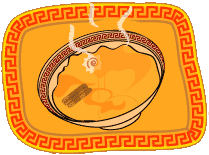
RAMEN
It's hard to get a decent bowl of Ramen outside Japan. Wouldn't it be great if you could make it at home? So thought I, and for the last several years I have been diligently researching the perfect recipe. I'm still working on it, but I've made enough progress that I feel I have something worth sharing. Here is a recipe for Richard's Miso Ramen. It draws from my experience in Hokkaido, Japan, where miso, rather than shoyu, ramen is the most popular.
Ingredients
For two bowls of Richard's Miso Ramen obtain the following:
Soup
(about 750-1000mL required for two bowls or ramen, but you make a batch and freeze in portions)
- 4L water or thereabouts
- 2 kg of uncooked chicken and/or pork bones
- a few chunks fresh ginger
- Bunch 'o greens (bok choy, chinese cabbage, spring onion tops)
- about 1 tablespoon salt
Base
- 1 tablespoon cooking oil
- 1 teaspoon sesame oil
- 1-2 cloves minced garlic
- 50 mL miso paste
- 25 mL soy sauce
- 1 tablespoon liquid vegetable and/or beef stock concentrate
- chili oil or dried red chili peppers to taste (need at least some heat)
Noodles
- 2 portions of noodles (1 cup of flour, one egg and a bit of water, if you have a pasta maker)
- salted, boiling water for cooking the noodles
- hot water to rinse noodles
- cooking time is as directed on package (3 minutes for fresh noodles)
Toppings
(as much as you like)
- sliced cooked pork
- tofu or beansprouts
- wakame
- chopped green onions
- sliced shitake mushrooms
Procedure
Summary of Procedure
There are four elements: Soup, Base, Noodles, and Toppings.
- The soup is prepared beforehand.
- Make the base, add to bowl.
- Prepare the toppings.
- Heat the soup and prepare the noodles.
- Add the hot soup to the bowl and mix, add the noodles.
- Quickly fry the toppings that need to be cooked and add them to the the bowl.
- Add the uncooked toppings and serve.
Soup
In a large soup kettle add some uncooked chicken and/or pork bones, some fresk ginger shopped into chunks, and some greens like bok choy, chinese cabbage and/or spring onions. Bring to a boil and simmer gently for 1-2 hours. Skim off the foam occasionally. Add salt to taste. Strain. Freeze and use for ramen, various soups and sauces.
The flavour may come from the base, but the body comes from the soup. If the worst comes to the worst, you can use water, or water flavoured with instant chicken stock, but for the real deal, you have to make your own soup stock.
Base
This is a paste of miso and flavourings that is the defining taste of miso ramen, so although it is fairly non-critical in terms of amounts and substitutions, it must be kept within certain bounds. Heat a tablespoon of cooking oil and a teaspoon of sesame oil and fry some minced garlic over medium heat. Add 1/4 cup of miso paste and 2T soy sauce. Add chili oil or chopped dried red chili peppers to taste. Cook over low heat for about a few minutes.
Noodles
There is some choice here. Chinese dried egg noodles work pretty well, but you can also buy fresh ramen noodles in some supermarkets or better yet make them yourself with a pasta maker. (Flour, egg, water) I'm also comfortable using dried udon noodles. Limit the use of instant noodles is to life and death circumstances only. Whichever, the finish is the same: poor the noodles into a sieve or colander, and rinse with boiling water. Drain and serve. The rincing part is to wash off the starch, and it is important.
Toppings
i. Richard's Miso Ramen. Fry some cooked, sliced pork slices and add soy sauce, mirin, and tofu or bean-sprouts. Cook it up for a while then add to the bowl. Top with chopped green onions, wakame, and optionally shitake mushrooms.
ii. Richard's Miso Ramen toppings show some Chinese influences, probably as a result of my time in Vancouver. For the real deal, check out the photo database at WorldRamen.Net.